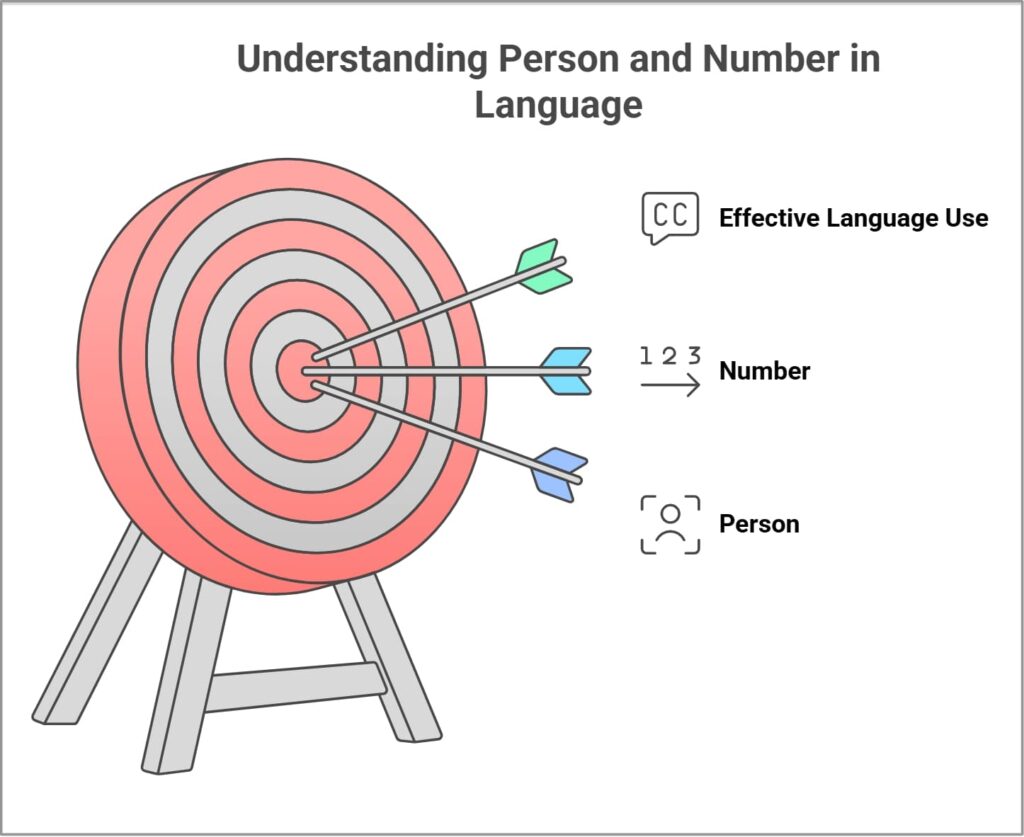Ever felt confused about whether to write “I am,” “you are,” or “they are”? You’re not alone! Understanding First Second and Third Person Singular and Plural forms is like learning the basic dance steps of English grammar.
As a language enthusiast and teacher for over a decade, I’ve seen how mastering these fundamental concepts can transform someone’s writing and speaking abilities. Let’s dive into this essential aspect of English grammar together!
Contents
ToggleBasic Person and Number Overview
First Person (I, We)
The first person refers to the speaker(s). Let’s look at how it works in both singular and plural forms:
| Number | Pronoun | Base Verb | Example | Context |
|---|---|---|---|---|
| Singular | I | am/have | I am happy | Speaking about yourself |
| Plural | We | are/have | We are team | Speaking about your group |
Second Person (You)
The second person addresses the listener(s):
| Number | Pronoun | Base Verb | Example | Context |
|---|---|---|---|---|
| Singular | You | are/have | You are kind | Addressing one person |
| Plural | You | are/have | You are all welcome | Addressing multiple people |
Third Person (He, She, It, They)
The third person refers to people or things being discussed:
| Number | Pronoun | Base Verb | Example | Context |
|---|---|---|---|---|
| Singular | He/She/It | is/has | He is tall | Talking about someone else |
| Plural | They | are/have | They are late | Talking about others |
First Second and Third Person Singular and Plural
Verb Changes Based on Person and Number
| Person | Singular | Plural | Present Simple Example |
|---|---|---|---|
| 1st | walk | walk | I walk / We walk |
| 2nd | walk | walk | You walk / You walk |
| 3rd | walks | walk | He walks / They walk |
Common Examples in Different Contexts
| Context | 1st Person | 2nd Person | 3rd Person |
|---|---|---|---|
| Home | I cook dinner | You wash dishes | They clean rooms |
| School | We study hard | You learn fast | She teaches well |
| Work | I type emails | You manage teams | He leads projects |
First Second and Third Person Singular and Plural Examples
| Person & Number | Example Sentence | Context |
|---|---|---|
| 1st Person Singular | I write poetry every morning. | Personal habit |
| 1st Person Plural | We attend yoga classes together. | Group activity |
| 2nd Person Singular | You play the piano beautifully. | Individual compliment |
| 2nd Person Plural | You all need to submit your assignments. | Class instruction |
| 3rd Person Singular | She bakes amazing chocolate cookies. | Individual skill |
| 3rd Person Plural | They travel around the world. | Group activity |
| 1st Person Singular | I am learning Japanese. | Personal education |
| 1st Person Plural | We organize community events. | Group responsibility |
| 2nd Person Singular | You speak three languages fluently. | Individual ability |
| 2nd Person Plural | You guys should arrive early tomorrow. | Group instruction |
| 3rd Person Singular | He designs websites professionally. | Individual occupation |
| 3rd Person Plural | They perform at local theaters. | Group performance |
| 1st Person Singular | I collect vintage stamps. | Personal hobby |
| 1st Person Plural | We volunteer at the animal shelter. | Group service |
| 2nd Person Singular | You understand complex mathematics. | Individual capability |
| 2nd Person Plural | You all passed the final exam. | Group achievement |
| 3rd Person Singular | It runs smoothly after the repair. | Object/machine |
| 3rd Person Plural | They teach at the university. | Professional group |
| 1st Person Singular | I practice meditation daily. | Personal routine |
| 1st Person Plural | We celebrate diversity in our team. | Group value |
Practice Exercises: First Second and Third Person Singular and Plural Usage
| Number | Exercise (Fill in the blank) | Person & Number Type |
|---|---|---|
| 1 | _____ (teach) English at the university. (I) | 1st Person Singular |
| 2 | _____ (go) to the market every Sunday. (They) | 3rd Person Plural |
| 3 | _____ (be) an excellent musician. (You) | 2nd Person Singular |
| 4 | _____ (write) code for major companies. (We) | 1st Person Plural |
| 5 | _____ (work) in the garden daily. (She) | 3rd Person Singular |
| 6 | _____ (study) together for exams. (You all) | 2nd Person Plural |
| 7 | _____ (have) three cats at home. (I) | 1st Person Singular |
| 8 | _____ (play) basketball professionally. (They) | 3rd Person Plural |
| 9 | _____ (read) mystery novels. (You) | 2nd Person Singular |
| 10 | _____ (cook) dinner every night. (We) | 1st Person Plural |
| 11 | _____ (fix) computers for a living. (He) | 3rd Person Singular |
| 12 | _____ (travel) to Paris next week. (You all) | 2nd Person Plural |
| 13 | _____ (speak) four languages. (I) | 1st Person Singular |
| 14 | _____ (dance) at the competition. (They) | 3rd Person Plural |
| 15 | _____ (live) in New York. (You) | 2nd Person Singular |
| 16 | _____ (meet) every Thursday. (We) | 1st Person Plural |
| 17 | _____ (sing) in the church choir. (She) | 3rd Person Singular |
| 18 | _____ (wait) for the bus. (You all) | 2nd Person Plural |
| 19 | _____ (drive) to work each day. (I) | 1st Person Singular |
| 20 | _____ (practice) yoga regularly. (They) | 3rd Person Plural |
Answer Key:
- I teach
- They go
- You are
- We write
- She works
- You all study
- I have
- They play
- You read
- We cook
- He fixes
- You all travel
- I speak
- They dance
- You live
- We meet
- She sings
- You all wait
- I drive
- They practice
Pro Tips:
- Remember that 3rd person singular adds ‘s’ or ‘es’ in present simple
- 1st and 2nd person forms don’t change in present simple
- ‘Be’ verbs (am/is/are) have special conjugations
- Plural subjects always use the base form of the verb
- When in doubt, identify the subject first, then determine its person and number
This exercise helps reinforce proper verb conjugation across different persons and numbers in English grammar.
FAQs on Singular and Plural Examples
1. Why does only the third person singular add “s”?
Because it helps show who’s doing the action. English keeps the “s” in he runs or she plays to make sentences clear and easy to follow.
2. How can I remember singular vs. plural?
Think simple:
- Singular = one (I, he, she).
- Plural = more than one (we, they).
Picture one person alone vs. a group — it’ll stick in your mind!
3. What’s different in British and American English?
British English often says “The team are playing” (plural).
American English says “The team is playing” (singular).
Both are correct — just different styles!
Conclusion
Understanding First Second and Third Person Singular and Plural forms is crucial for effective English communication. Remember that practice makes perfect, and these patterns will become second nature with time. Keep these examples and rules handy as you continue to develop your language skills.

